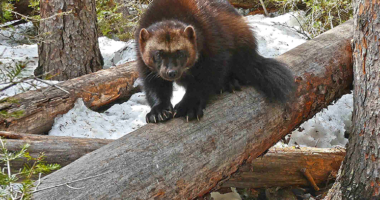On Wolverines

I’ve learned a lot about wolverines in the last few weeks and want to share some of the what, why, and ‘that’s cool’ part of my adventure. About 15 months ago, a family friend killed an elk in Lewis and Clark County and trained a trail-cam on the gut pile to see which scavengers might visit. One of the animals photographed was a wolverine.
I recently found myself sitting next to someone who knew Kalon Baughan, who specializes in monitoring wolverines. If I sent her the picture, she’d share it with Kalon and—maybe—the animal could be identified.

Photo by Kalon Baughan, courtesy Northern Rockies Conservation Cooperative.
It turns out this critter was indeed known: the animal that was photographed is nicknamed M6. At the time, he was likely the second oldest wild male wolverine known in the Northern Rockies (the oldest one was in the Jackson, Wyoming area). Similar to human fingerprints, wolverines are identified by their light fur markings on their neck and chest—and the photo my friend took showed enough distinct markings to confirm identification.
M6 was first found in the Beaverhead-Deerlodge National Forest in 2010. He has since been photographed numerous times. The trail-cam picture captured in late 2016 is the last photo taken of him that I’m aware.
Although M6 was still wandering around Montana in 2016, we don’t know if he still survives. If M6 was one year old when he was photographed in 2010, he would be a minimum of nine years old in February 2018.
Learning about M6 piqued my interest about the natural history of these animals. Just to give you a sample of what I learned:
- Wolverines are the largest member of the weasel family in the Rocky Mountains. In Montana they’re about the size of a medium dog (30 inches to 50 inches – including tail- weighing 15-45 pounds). Males are larger than females.
- Wolverines living in Montana are generally found in the western third of the state. They have low population densities and large territories (one study suggested males in Montana can range 160 square miles, females slightly less).

Photo of M6 by Kalon Baughan.
- These animals primarily live in mountainous alpine terrain and montane-boreal forests, preferring roadless wild country to clearcuts or burned areas. They tend to occupy higher elevations in summer and lower elevations in winter. Sometimes they disperse great distances (M6 has wandered a lot!).
- Although carrion accounts for most of their diet, wolverines eat everything and anything, preying primarily on small to medium sized mammals, but willing to consume berries, eggs, birds, and more.
- In Montana, females generally den around February, which includes burrowing into snow. Their 2-3 ‘kits’ are generally weaned in mid-May.
- Wolverines are built for living in cold snowy country—their fur is frost-phobic and they have long legs and “snowshoe” sized feet that aid long distance travel through snow. In addition, snow may be crucial for denning, ease of travel, and preservation of carrion, adding concerns that climate change may shrink wolverine populations.
- Wolverine are currently classified as a furbearer in Montana, with the trapping season closed. However, incidental trapping of wolverine occurs, which requires trappers to notify authorities promptly. They are not protected by federal law.
- In the wild wolverines generally live to about 10 years old but can reach 15.
To learn more about wolverines use:
My adventure learning about wolverines reminds me how little we know about many wildlife species. It also made me appreciate how legal uses of a remote camera can produce important information for biologists (for more information on the illegal uses of a remote camera, visit 87-6-401 (1)(d) MCA)!
I’ll let you know if any newer photos show up of M6.
Post written by Janet Ellis, Senior Director of Policy, Montana Audubon. TOP: Photo of M6 by Kalon Baughan.

Photo of M6 by Kalon Baughan.